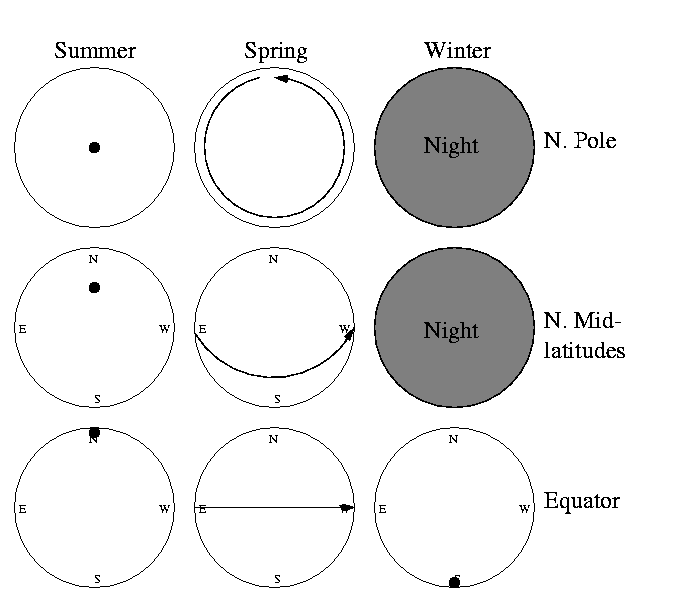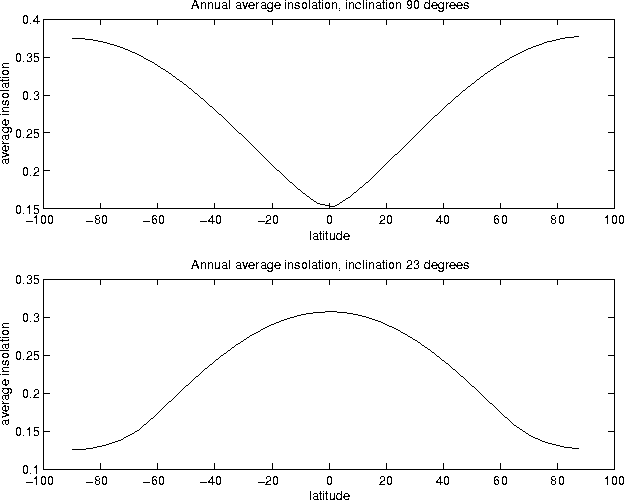
| MadSci Network: Earth Sciences |
What an interesting question! As you know, Earth's axis of rotation is tilted by 23 degrees from the vertical, where "vertical" is out of the plane of its orbit. This tilt causes the change in day length and sun angle. During summer, the sun is high in the sky and heats the ground up more; during winter, it's low in the sky and heats the ground less.
Uranus, however, is tilted by about 90 degrees. What would happen if Earth had this much tilt? I'll call this situation "tilt world", to distinguish it from the "real world".
During northern summer on "tilt world", the Earth's axis would point directly at the sun. As the Earth spins, the Sun would not appear to change position: it would hover in one spot in the sky, and would never rise or set -- it would always be daytime in the northern hemisphere. In contrast, during northern winter, the Sun would appear to hover over the South Pole, and so the northern hemisphere would be in complete darkness, always nighttime.
In the "real world", we see this sort of thing happen in the extreme arctic and antarctic: at the North Pole there is a full half-year of sunshine followed by a full half-year of darkness. But in "tilt world", the whole planet would be like this. In North Pole summertime in the "real world", the sun stays very low in the sky, reducing the amount of light which hits the Earth. But during "tilt world"'s summer, the North Pole would receive constant "high noon" sunlight for several months!
As summer changed to fall, the sun would appear to make bigger and bigger circles in the sky; in the springtime "tilt world" would have a fairly normal day and night.
This cycle is summarized in the figure below. It shows the path of the sun through the sky during the various northern-hemisphere seasons, for various locations in the northern hemisphere. The circle represents the sky (with compass directions marked), and the line shows the path of the sun through the sky. So for example, the upper row, middle column shows that during springtime at the north pole, the sun moves around in a circle right along the horizon. The bottom left panel shows summer at the equator: the sun hovers at the northern horizon.

As you can imagine, sunlight all day and all night for the whole summer would make for a pretty hot summertime, and constant darkness all day and all night would make for a pretty cold winter. A very rough estimate makes me think that during summertime, the temperature at the poles could average 75 degrees C (165 F), possibly even more far from the oceans. During winter, it could average -10 C (14 F). In the middle latitudes, summers might average 50 C (120 F) and winters might average -20 C (-4 F).
This leads us to an interesting point. If we average over the whole year, we find that for "tilt world", the spot which gets the least yearly-average sunlight is the equator; the poles get the most sunlight. This is the exact opposite of the "real world", where the tropics are sunny and the poles are dark. Why is this so? On "tilt world", at the equator, the sun always hovers very low in the northern or southern sky, except for a brief period during spring and fall where it follows a "normal" pattern of day and night cycles. Thus, for most of the year, the equator receives very little sunlight.
The figure below shows how the yearly average amount of sunlight ("insolation") changes for different latitudes (+90 is the north pole, 0 is the equator, -90 is the south pole). The upper picture shows "tilt world"; the lower panel shows the "real world".

The parts of the Earth that get the least sunlight will be the coldest. So we see that, on average, the coldest part of "tilt world" is the equator! I estimate that the equator of "tilt world" would have a yearly average temperature of about -5 C (20 F); it might get as warm as 10 C (50 F) during spring and fall. This means that all the glaciers, ice sheets, and permanent sea ice on "tilt world" would be in the tropics, near the equator!
In addition, this reversal of yearly average temperatures would change the weather a great deal. The average winds on "tilt world" will probably go in the opposite direction from the "real world" -- where you live, they'd come from the east instead of the west. Winds will be very strong during the summertime, with calmer conditions in the winter -- opposite of the "real world". Snowfall will probably be very large, because of the huge amount of water evaporated into the atmosphere on the hot, sunlit side of the planet. Strong hurricanes will probably be very common in the middle latitudes and the poles during summer, and nonexistent in the tropics -- the opposite of the "real world".
In a word, the weather would be awful. You couldn't live where you live now: the heat during the summer would probably kill you. I can't think of a single place on "tilt world" which wouldn't be too hot during the summer or too cold during the winter. The equator would be unpleasantly cold all the time, but better than nothing. Your best bet would be to live in the northern tropics (say, Florida) during northern winter, and go south to Brazil for northern winter.
A word of warning: many of my predictions in this section are based on simple formulas and extrapolations based on Earth's climate. Climate systems are tremendously complicated, and you shouldn't put too much confidence in the results I've quoted here, because there are lots of important things I've ignored. These things include cloudiness and atmospheric moisture, atmosphere and ocean circulation, ice, and changes in land surface and atmospheric composition due to modified ecosystems. I am fairly confident that the equator will be the coldest on average, and that most places will have a huge temperature difference between summer and winter, but the numbers I've quoted could be off by a large factor.
Try the links in the MadSci Library for more information on Earth Sciences.